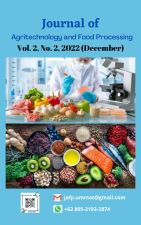The addition of cashew pseudo-fruit by different concentration towards chemical and organoleptic quality of dumbo catfish floss
DOI:
https://doi.org/10.31764/jafp.v2i2.13311Keywords:
floss, African catfish meat, cashew nutAbstract
Shredded floss is a food product made from main raw materials, namely beef, chicken and fish. Shredded floss is generally used as an energy source because it contains a lot of protein. This study aims to determine the effect of the addition of cashew fruit on the chemical and organeleptic properties of African catfish shredded. This study was designed using a Completely Randomized Design (CRD). Data were analyzed using the Honest Significant Difference Test (BNJ) at 5% level in one aspect, namely the addition of cashew and African catfish pseudo-fruits with the following treatments: P0 0%: (100% African catfish meat as control), P1 African catfish meat mixture 100%: 20% cashew fruit, according to the weight of the ingredients, P2 A mixture of African catfish meat 100%: 30% cashew pseudo fruit, 100% P3 A mixture of African catfish meat: 40% cashew pseudo fruit, P4 African catfish 100% cashew fruit 50%. The results of this study indicate that the treatment of adding cashew fruit to the chemical and organeleptic properties of shredded catfish has an effect on significantly on chemical properties (parameters moisture content, protein content and fiber content) whereas organeleptic properties have a significant effect on parameters of color, taste and aroma, but no significant effect on texture. The best treatment was obtained in the P3 treatment (200 grams of African catfish meat 40% cashew nuts) with a water content of 14.62%, protein content of 17.10%, fiber content of 32.49%. The taste is very like, the color is slightly brownish, the aroma is like and the texture is rough.
References
DAFTAR PUSTAKA
Afriyanti, A., & Asmoro, N. W. (2017). Pendugaan Umur Simpan Sirup Buah Semu Jambu Mete (Anacardium occidentale, L) dengan Metode Accelerated Shelf Life Testing (ASLT). AGRISAINTIFIKA: Jurnal Ilmu -Ilmu Pertanian, 1(2), 75. https://doi.org/10.32585/ags. v1i2. 42
Anugraini, L., Ansokowati, A. P., & Gizi, P. S. (n.d.). Daya Terima Abon Ikan Lele Dumbo (Clarias gariepinus ) Kombinasi Sebagai Alternatif Pangan Darurat. 1–9.
Arrias, J. C., Alvarado, D., & Calderón,M.(2019).substitusi kluwih (Artocarpus camansi) terhadap sifat proksimatdan organoleptik abon ikan gabus (channa striata ). 5–10.
Asmawati, A., Marianah, M., Fayiz, M., Atoum, M., Sari, D. A., Iqrar, I., Hussain, Z., Setyobudi, R. H., & Nurhayati, N. (2022). The Potential of Cashew Apple Waste as a Slimming Agent. 15(5), 887–892.
Elfayetti, Herdi, Rosni, & Pinem, K. (2014). Perbedaan Kualitas Ikan Lele Dumbo Dengan Ikan Lele Lokal Dalam Pembuatan Abon Ikan. Jurnal Pengabdian Kepada Masyarakat, 20, 70–77.
Harianti, R., & Tanberika, F. S. (2018). Pemberdayaan wanita tani melalui produksi abon ikan lele. JPPM (Jurnal Pendidikan Dan Pemberdayaan Masyarakat), 5(2), 167–180. https://doi.org/10.21831/jppm. v5i2. 21071
Koten, B. B. (2010). Kandungan Nutrien Silase Buah Semu Jambu Mete Sebagai Pakan Pada Berbagai Level Tepung Gaplek Dan Lama Pemeraman. PARTNER. Buletin Pertanian Terapan, 17(2), 120–126. https://jurnal.politanikoe.ac.id/index.php/jp/article/view/52
Lestari, N. (2020). Uji Beberapa Konsentrasi Tepung Daun Serai (Cymbopogon citratus (DC.) Stapf.) Terhadap Mortalitas Hama Kutu Beras (Sitophilus oryzae L.). Skripsi.
Listyarini, S., Asriani, A., & Santoso, J. (2018). Konsentrat protein ikan lele dumbo (Clarias gariepenus) afkir dalam kerupuk melarat untuk mencapai Sustainable Development Goals. Jurnal Matematika Sains Dan Teknologi, 19(2), 106–113.
Mustofa, A. (2010). Potensi Produksi Bioetanol Dari Buah Semu Jambu Mete (Anacardium occidantale L.). Joglo, 22(1).
Nasution, S. (2003). Metode Penelitian Naturalistik Kualitatif (Bandung). Tarsito. Library. Fis. Uny. Ac. Id/Opac/Index. Php.
Ninna Rohmawati, Sulistiyani, L. Y. R. (2013). Pengaruh penambahan keluwih. Ikesma, 9, 1–15.
Notoatmodjo, S. (2005). Metodologi penelitian kesehatan cetakan ketiga. Jakarta. PT. Rineka Cipta.
Nur, N., JUN, D., & SYAF, S. (2017). Uji Priksimat Abon Ikan Lele Dumbo (Clarias Gariepinus) Di Kecamatan Rimbo Ulu Kabupaten Tebo Provinsi Jambi. SEMAH Jurnal Pengelolaan Sumberdaya Perairan, 1(1).
Rohmawati, N., Sulistiyani, S., & Ratnawati, L. Y. (2013). Pengaruh penambahan keluwih (Artocarpus camasi) terhadap mutu fisik, kadar protein, dan kadar air abon lele dumbo (Clarias gariepinus). IKESMA, 9(2).
Sudarmadji, S., Suhardi, & Haryono, B. (1989). Analisa bahan makanan dan pertanian. Liberty Yogyakarta bekerja sama dengan Pusat Antar Universitas Pangan.
Downloads
Published
Issue
Section
License
Authors who publish with this journal agree to the following terms:
1. Authors retain copyright and grant the journal right of first publication with the work simultaneously licensed under a Creative Commons Attribution License that allows others to share the work with an acknowledgement of the work's authorship and initial publication in this journal.
2. Authors are able to enter into separate, additional contractual arrangements for the non-exclusive distribution of the journal's published version of the work (e.g., post it to an institutional repository or publish it in a book), with an acknowledgement of its initial publication in this journal.
3. Authors are permitted and encouraged to post their work online (e.g., in institutional repositories or on their website) prior to and during the submission process, as it can lead to productive exchanges, as well as earlier and greater citation of published work (See The Effect of Open Access).

